Silk Road in Turkey
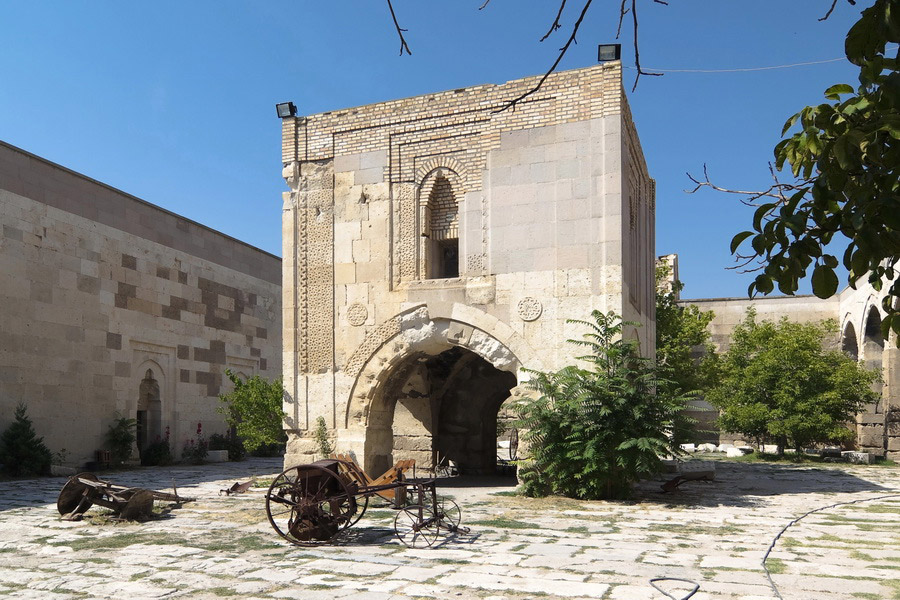
Origins of the Silk Road
Embarking on a Silk Road Tour is the best way to appreciate the importance, the greatness, and the impact it had on the world.
The ancient routes of the Silk Road (Uzun Yol) originated from China, in Xi'an, in the 2nd century B.C., when the Chinese ambassador Zhang Qian, sent by Emperor Wu of the Han dynasty, embarked on his diplomatic mission to Central Asian countries. To say that he was amazed by what he had discovered would be an understatement! He was blown away by how the people had managed to build a life so lavish in these foreign lands. Needless to say, the stories about what he had witnessed became the inspiration to exchange precious goods between countries that would have been disconnected otherwise.
This network swiftly became the most important trade system that linked the East to the West, but it was not linear. Depending on the transported goods, weather conditions, or even the political state of a particular region, the courses would differ.
Was the Silk Road the First of its Kind?
The short answer is no. Trade has been a critical part of humanity for centuries before the first merchants embarked on the Silk Road. The Royal Road of Persia was first established in the fifth century B.C. during the reign of Darius I. He made this network by utilising several already existing courses, upgrading them and keeping them maintained. Not only was this a stellar means for expanding trade but also unifying Persia. People and products were being protected by the royal guards, and all the necessary infrastructure was created to keep the travelling merchants as comfortable as possible. Due to how long ago it operated, the exact routes are unknown, but it was estimated that the Royal Road went from Susa in Persia (in the southwest of present-day Iran) to Sardis (about 80 kilometres west of Izmir).
The Routes of the Silk Road in Anatolia
Anatolia (Anadolu) or Asia Minor was the name given to the peninsula covering almost the entirety of modern Turkey (Türkiye) at the time. The Silk Road here originated during Roman rule, when Alexander the Great started his expedition to the East. Since then, the region continued to be a prominent part of it for more than 10 centuries. Its strategic geolocation played a huge part in connecting two continents, and the route not only used the land but the sea as well. The Thrace was the key link between Europe and Asia in the Middle Ages, and Anatolia was the connection merchants needed to reach their destination. This region saw significant prosperity during the Seljuk rule, as they were responsible for developing and maintaining economic stability and growth.
Land Routes
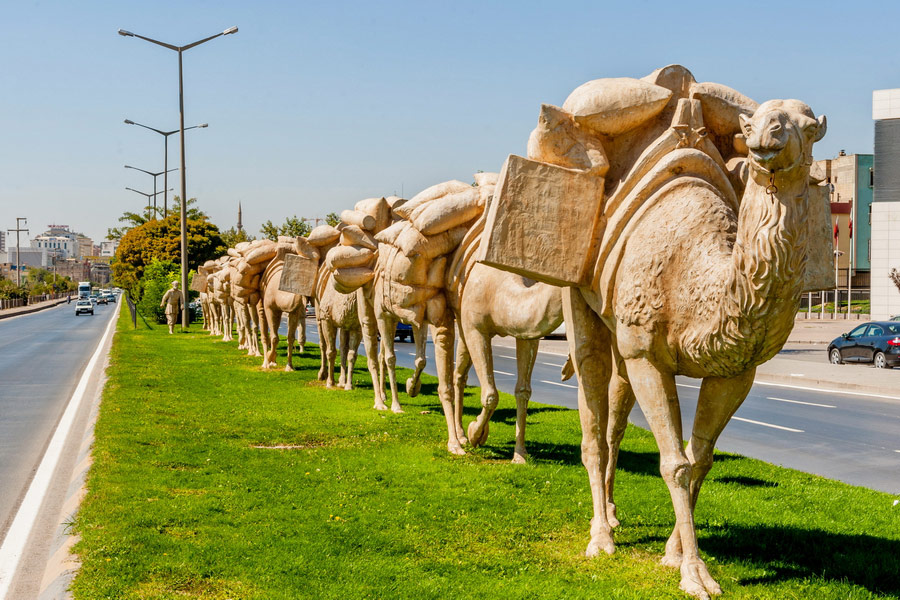
The Anatolian peninsula was the most important part of the network since the precious goods entered the region through the Caucasus and the Middle East. Trabzon, historically known as Trebizond, was a starting point of the Northern Routes.
The Northern Routes
From Trabzon, caravaners went a little south to Gümüşhane and then to the east to Erzurum (Theodosiopolis), after its conquest by the Seljuk Turks. The snowy mountains served as a shelter and protector to them, and the path continued to the city of Sivas (Sebaste), then Tokat (Dokia), Amasya (Amaseia), Kastamonu, Adapazarı (Adacık), Izmit (Nicomedia), and, eventually, Istanbul (Constantinople) and Edirne (Adrianople).
There are three main known variations of the Northern Routes that changed depending on the oncoming cargo, its destination, and other factors:
- The Central Route
This course connected the Persian Gulf, Baghdad, and Syria to Mardin, Diyarbakır (Amida), Malatya (Melitene), Sivas (Sebaste), and the city of Amasiya (Amaseia). The rest of the route continued up to Istanbul (Constantinople) and, eventually, crossed the European border.
- The Diagonal Route
This was the “unbreakable” course for various reasons, one of which being the fact that it continued operating even during the Arab and Turkish conquests. Moreover, it was one of the main Military Roads for the Ottomans. From Europe to Asia, it went from Istanbul to the Adana province, the city of Mersin (Tarsus) to be exact. Then, merchants would go to Antakya (Antioch), which eventually led them to Damascus (Şam, in Turkish) and Mecca (Mekke, in Turkish). It is worth noting that even after the trade routes of the Silk Road ceased operating, the way was still being used by the annual pilgrim caravans travelling to Mecca and the Christians travelling to Jerusalem.
- Other Routes
Erzurum (Theodosiopolis) seemed to be the linking point of the Caucasian and Iranian courses, notably from Tabriz (Tebriz). Whether it was from Georgia, Armenia, or Iran - upon crossing the border, travellers would reach Erzurum and move on to the Anatolian part of the route from there.
The Southern Routes
The southern part of the trade in Turkey started from Mardin, a major city closest to Syria. Then, it proceeded to Diyarbakır and Adıyaman, then slightly to the north, to Malatya, and back down to Kahramanmaraş (Germanikeia or Marash). After this, travellers would cross over Cappadocia towards Kayseri (Caesarea or Mazaca), Nevşehir (Neapolis or Muşkara), Aksaray (Archelais Garsaura or Taksara), Konya (Iconium), Isparta (Saporda), Antalya (Attalea), and through Denizli, crossing the European border. The alternative land itinerary went from Erzurum to Malatya, Kayseri, Kirşehir (Justinianopolis), Ankara (Ancyra or Angora), Bilecik (Belokome), Bursa (Prusa), Iznik (Nicaea), Izmit, and ended in Istanbul.
Sea Routes from Anatolia
Land wasn’t the only way goods were being transported in the Turkish part of the Silk Road. The country is a peninsula and connects to Europe through the Mediterranean Sea, which played a huge strategic role in the commerce. The most significant port cities in this chain of product exchange were Trabzon, Bursa, and Sinop on the Black Sea coast; Alanya (Coracesium or Alaiye) and Antalya in the Mediterranean; Efes (Ephesus) and Milet (Miletus) on the Aegean coasts; Istanbul, Izmir (Smyrna or Foça), and Antakya.
Maritime courses that ran across Turkey can be divided into two ways: the Black Sea and the Mediterranean Sea routes. The former began from contemporary Batumi (Batum) and continued to Trabzon, then Samsun (Amisus), Sinop, Istanbul, Bursa, and Gelibolu (Gallipoli) on the Gallipoli peninsula, and eventually reached Venice in Italy. As for the Mediterranean route, it went from Syria to Antakya, Antalya, Izmir, and, finally, Europe.
Was Travelling in Anatolia Safe for Merchants?
While highway robbery was a heavily punishable crime under the Islamic-Ottoman legislation, bandits still existed on the road. Over the centuries, different methods were used to preserve the safety of the merchants. Arguably, the most effective one was created by the Seljuks and was known as the “Derbend Organisations”. What this state insurance system entailed was simple: having guards posted at the mountain passes to avoid robberies throughout the villages and cities that were being passed.
Where Did the Caravaners Rest in Anatolia?
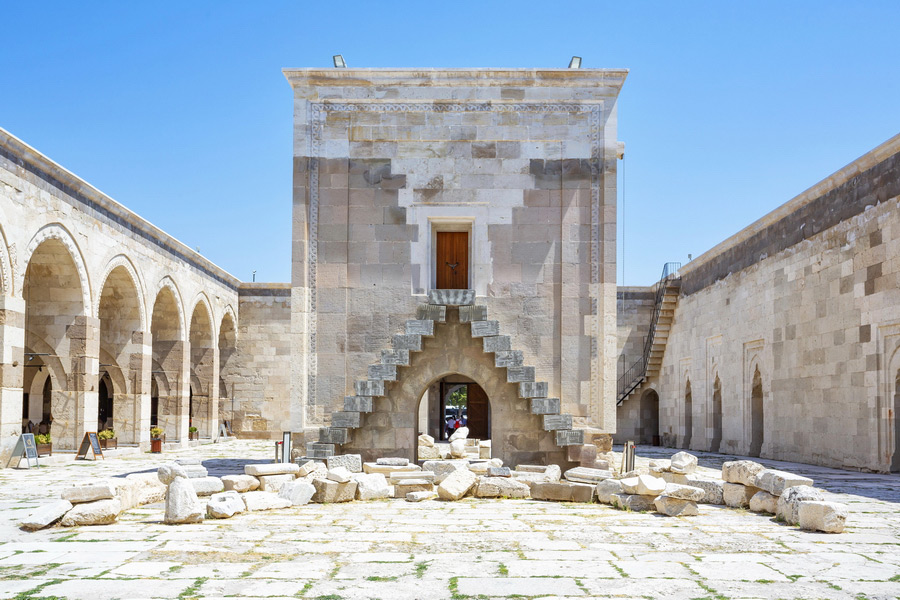
With a strenuous trip ahead, travellers needed a place to periodically take shelter from the elements and manage to rest until they proceeded with their journey. Often, not only did they have to deal with the weather conditions in the desert, the mountains, and the sea, but also getting robbed on the road. For this reason, a new type of facility started emerging on the Silk Road map in the 13th century.
“Caravanserai” is a word of Persian origin and translates as “a caravan palace”. These roadside inns were specially made for merchants, with enough distance in mind that those who sought accommodation could reach them after a day’s worth of travel, in roughly 30–40-kilometre intervals. The rectangular (or sometimes square) facilities not only provided overnight shelter for caravanners and their animals but also protected them from bandits, as the chance of getting robbed at night in the inn was slimmer.
Caravanserais were provided with water for consumption, washing, and ritual purification. Some of them had small mosques for prayer, especially in Muslim countries like on the Anatolian peninsula, where Islam was the main religion practiced. It was also common for these facilities to have hammams (Turkish baths). Anatolia was the home of approximately 200 inns and caravanserais, half of which can still be visited, and some Ottoman hammams have survived the centuries and can be viewed in Bursa and Edirne.
Commerce and Cultural Relations on the Silk Road
The transported goods varied depending on their origin and destination. From west to east, merchants brought animals such as horses, notably the heavenly horses of Fergana; camels; dogs; and other species; animal furs and skins; food such as fruits, honey, spices, grapes, and wines; and many other ailments; glassware; weapons; armour; textiles; precious metals like gold and silver; slaves; and many more. On the contrary, silk, tea, spices, fine china and porcelain, precious stones, medicine, perfume, rice, paper, gunpowder, and dyes were being transported from the east.
The Anatolian Peninsula lay right between Europe and Asia, serving as a connecting bridge between different cultures and civilisations, where modern-day Turkey linked the Caucasus to Europe. Itineraries differed depending on the source of the cargo, but there were some main routes used in trade.
Besides the trade aspect, caravanserais were one of the greatest opportunities at that time to exchange news, language, religious beliefs, culture, and customs—a wonderful chance of sharing and learning about new practices and technologies.
Anatolia's Contribution to the Silk Road
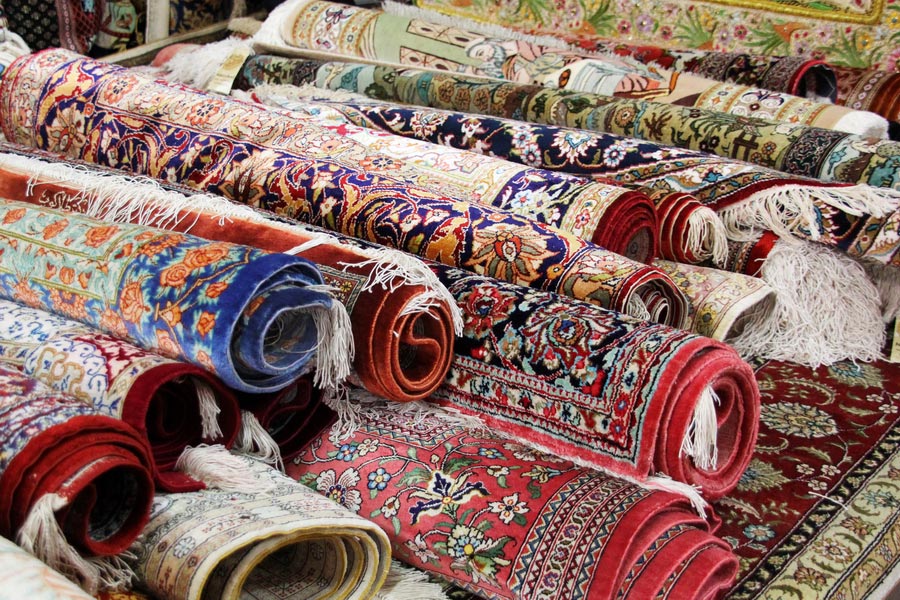
The Silk Road was a perfect opportunity to highlight local arts and give people a chance to showcase their talents to the whole world. For instance, Bursa was known as the centre of silk production during the Ottoman Empire’s rule; high-quality carpets were woven in Kayseri and Konya; interesting spices, leather goods, and precious stones could be found in Istanbul (Constantinople); Iznik was famous for its ceramics and, particularly, gorgeous and unique tiles. All the local crafts played a huge role in the significance of the Turkish cities.
Legacy of the Silk Road in modern Turkey
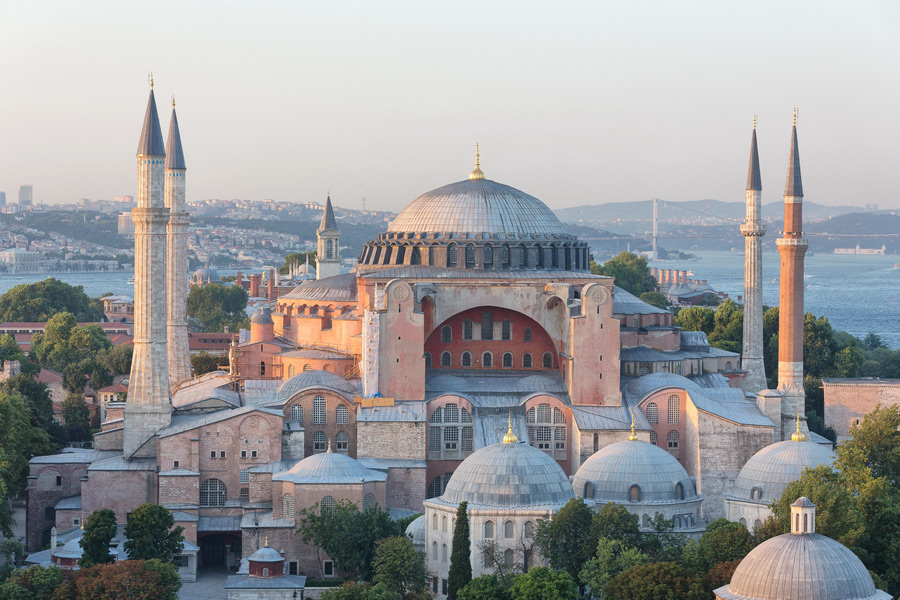
Ideas and skills were constantly being exchanged, explored, and adapted to local standards. Cities prospered and brought subsequent development in arts, science, and even religion. Constantinople (modern-day Istanbul), as the capital and the largest city of the Byzantine Empire, was the central trade hub. Most of the merchants from Asia flocked there, as at the crossroads of two continents, it was one of the last stops before the travellers moved on to Europe.
On the Turkish section of the Silk Road, it is still possible to see a number of architectural landmarks of historical importance. For example, in Istanbul, you can visit the Hagia Sophia (now a mosque) and Topkapi Palace; in Bursa, you can go to the local silk market, as well as the Seljuk-built caravanserai (Kosa Han); Konya and Erzurum have maintained the historical madrasahs, like Karatay Madrasah (Karatay Medresesi) and Yakutiye Madrasah (Yakutiye Medresesi). These educational institutions were usually religious in nature and taught theology and various important subjects at that time. They were heavily affected by the innovations and knowledge brought in by the foreign nomads.
Places and landmarks that have been inscribed in the World Heritage List by UNESCO and are linked to the Silk Road include:
- Divriği Great Mosque and Hospital (Divriği Ulu Cami ve Darüşşifası);
- Historic Areas of Istanbul;
- City of Safranbolu;
- Selimiye Mosque and its Social Complex (Selimiye Camii) in Edirne;
- Bursa and Cumalıkızık: at the Birth of the Ottoman Empire.
Aside from the architecturally and historically significant legacy, this trade network left a mark on Turkish customs and has bequeathed us an intangible heritage. The creation and development of the following arts and practices were encouraged through this exchange:
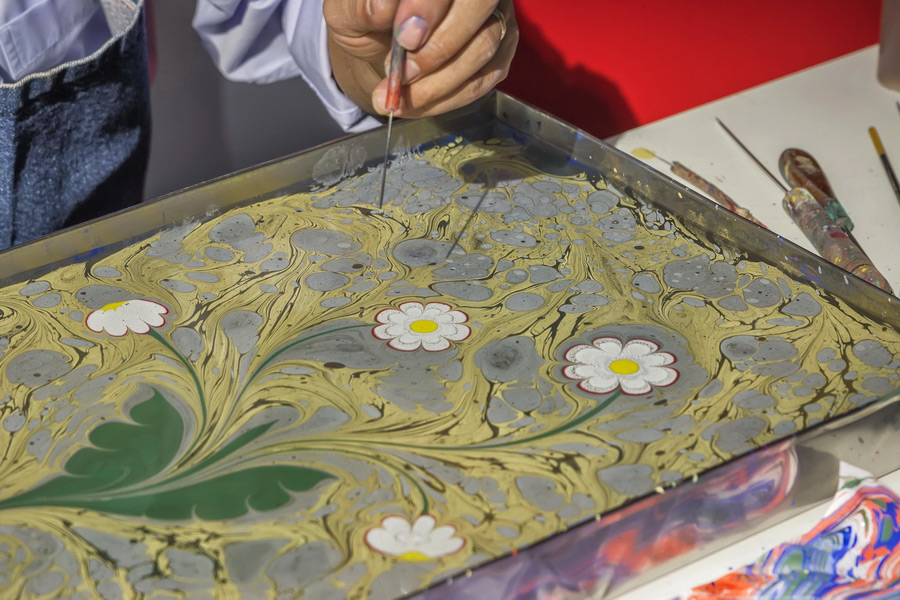
- Arts of the Meddah—the art of storytelling that is improvisational in nature;
- Mevlevi Sema ceremony—a unique whirling Dervishes ceremony that has Sufism religious roots;
- Âşıklık (minstrelsy) tradition—a form of expression that usually combines musical, poetic, and narrative elements.
- Nowruz (Nevruz)—a celebration marking the New Year and the beginning of spring. Celebrated in Turkey, Azerbaijan, Iran, Pakistan, Uzbekistan, and in more countries.
- Ebru—the Turkish art of marbling.
The “New Silk Road”: One Belt, One Road
The Silk Road as we know it ceased to exist after the Ottomans boycotted the trade with the West between 1453 and 1660 C.E., and this is the reason why maritime routes were used instead. Nevertheless, the road was slowly getting abandoned, eventually leading to the end of the elaborate network.
Centuries later, in the 2010s, the significance of the Silk Road was discussed in various contexts. The Belt and Road Initiative (BRI) proposal to resurrect this ancient trade route and re-establish the link between Asia and Europe via both land and the sea, utilising modern railway systems and port cities, has been brought forward and adopted by the Chinese government. While globalisation has reached its peak, reviving the Silk Road would highlight its cultural and historical legacy again, potentially attracting more tourists.
The international “Middle Corridor” initiative, also known as TITR (Trans-Caspian International Transport Route), is a project that garnered increased attention after the initial start of the Russo-Ukrainian war in 2014. This is the most direct trade route from Western China to Europe, with Turkey playing the key role. Notably, the Baku–Tbilisi–Kars (BTK) railway stands as one of the critical railway systems in this corridor, alongside the Trans-Kazakhstan railroad. Additionally, as part of the broader “New Silk Road” initiative advocated by President Recep Tayyip Erdoğan, the Istanbul–Tehran–Islamabad railway freight train service serves to connect Turkey, Iran, and Islamabad in Pakistan.
Historical Figures Who Travelled the Silk Road in Anatolia
Throughout the centuries, various historical figures, explorers, and missionaries have embarked on their Silk Road journey through Anatolia. Here are some of the most prominent people among them:
- Marco Polo, his father, and his uncle—the famous traveller and writer went on a journey with his father and uncle from 1271 to 1295. The older pair were merchants who had already experienced the Silk Road, but with Marco, they reached China by travelling through Persia and Central Asia. On their way back, they decided to go overland to the Mediterranean, one of the stops being Constantinople.
- Ibn Battuta—the renowned Maghrebi scholar and traveller began his journey in 1325 and ended it in 1354. His original goal was to join the pilgrimage to Mecca (hajj), the route of which went through Mardin. After his third pilgrimage to Mecca, he stayed a few years in Antalya and visited Konya and Eğirdir. Notably, his description of this region has since become immensely valuable.
- John Newbery—this London merchant went on the Silk Road trip three times in total. First, in 1579. Then, in 1580-1582 and 1583-1584. The second expedition is when he ended up in Anatolia. It is worth mentioning that he was the first Englishman to visit some of the regions on the Silk Road. He sadly passed away on his way back home during the third journey.
- Ascelin of Lombardia and Simon of Saint-Quentin—both Dominican friars and diplomats. Sent as envoys to Mongolia by the Pope Inocent IV in 1245. While they were returning from their mission, they travelled through Antioch, among other cities.
- Friar Odoric of Pordenone—this Italian Franciscan friar and missionary started his mission in the early 14th century, 1318 to be exact. He went from Padua to Venice, then the Mediterranean, Trabzon, Armenia, and Iran.
- Ruy Gonzáles de Clavijo and Alfonso Páez—between 1403 and 1406, ambassadors of the Spanish King, Henry III of Castile, were sent to the Turco-Mongol Amir Timur (Tamerlane). who resided in modern-day Samarkand, Uzbekistan. They proceeded from the Mediterranean to Constantinople, then Trebizond, and, finally, reached their destination. Clavijo wrote about their expedition in detail, and this material became crucial for future European travellers.

